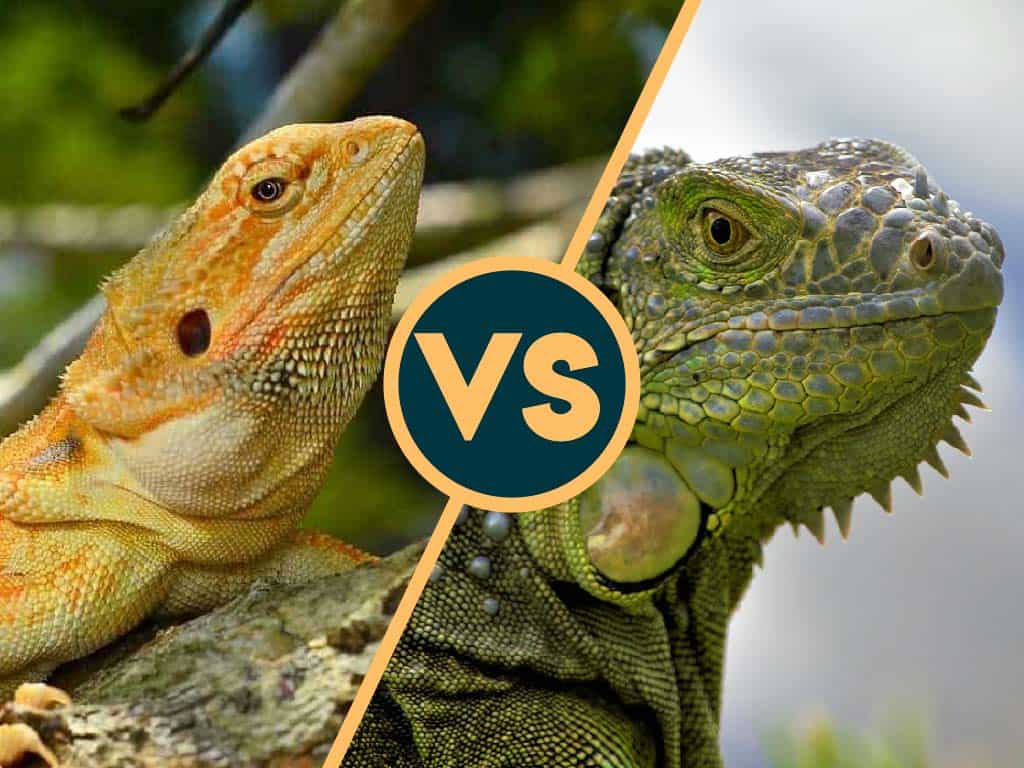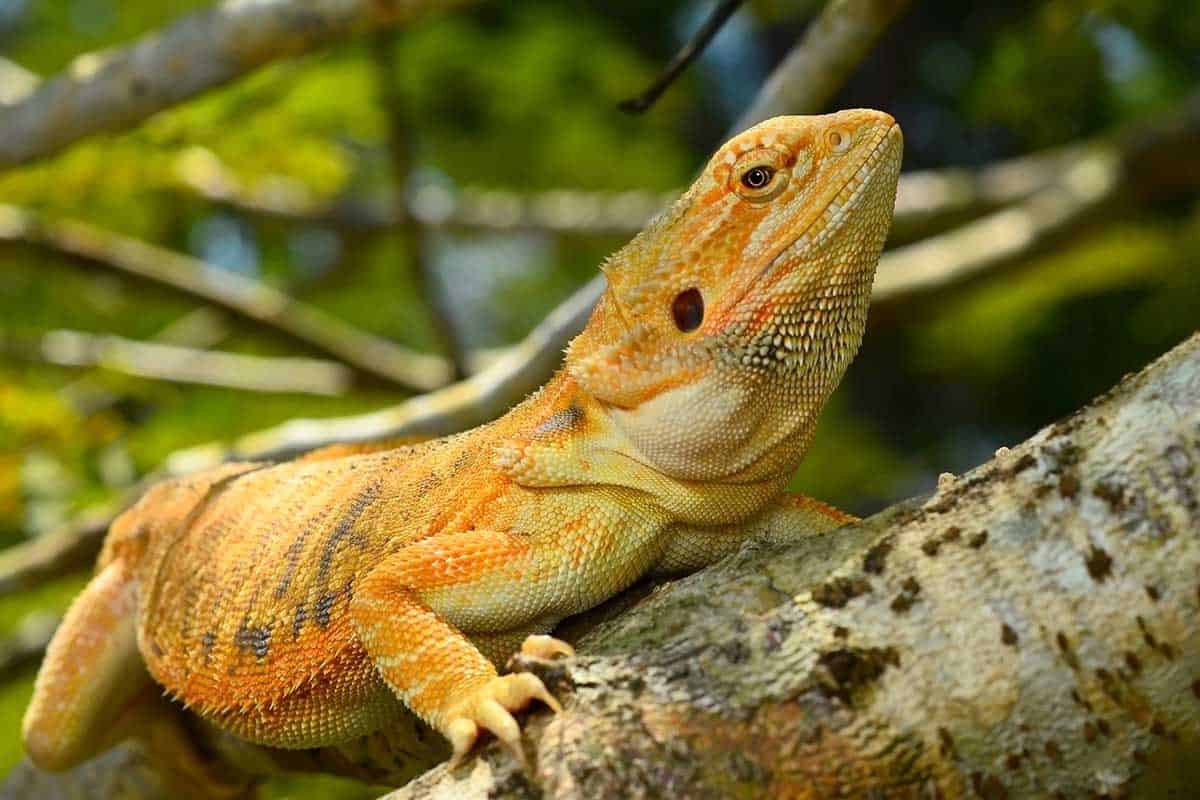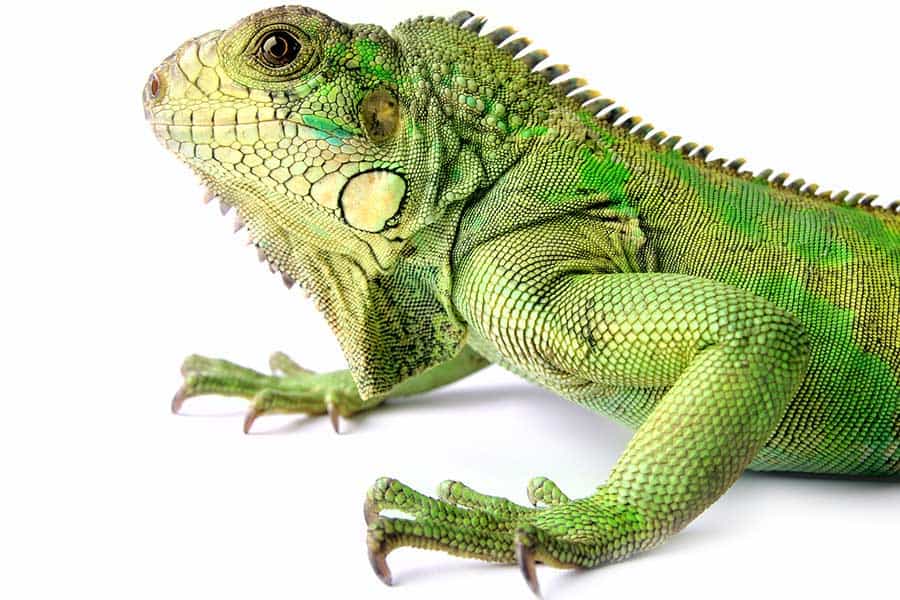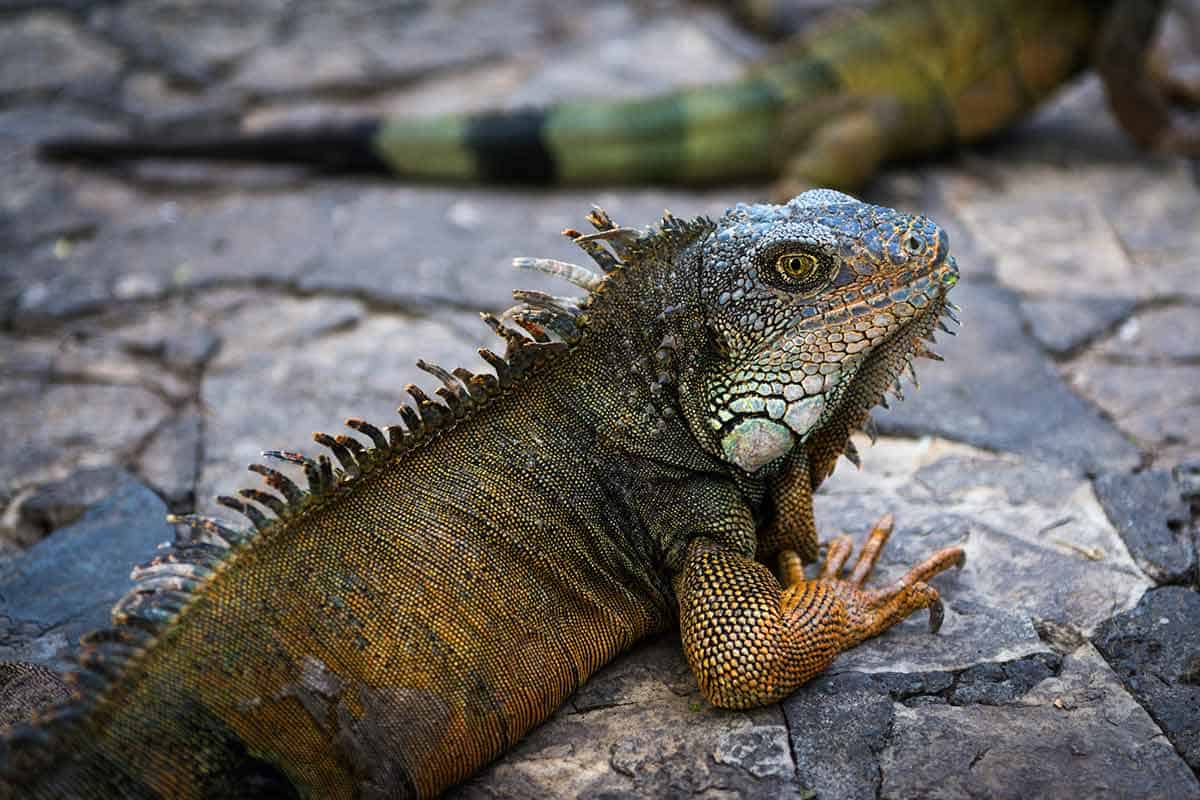Bearded dragon vs iguana, which is the best pet lizard for you?
Bearded dragons and iguanas both make great pet lizards, even for kids and beginner herpes! However, there are some key differences between the two scaly beasties that will mean they are better suited to different owners’ lifestyles.
The differences in size, diet, husbandry requirements, and personalities will help you decide which lizard fits into your life better.
Read on to find out who is the winner between bearded dragons and iguanas!
Main Differences Between Bearded Dragons vs Iguanas
The main differences between bearded dragons and iguanas are:
- Bearded dragons are relatively small and measure at roughly 20 inches, whereas iguanas are much larger and can grow up to 7 feet from snout to tail tip.
- Bearded dragons have smaller enclosures, whereas iguanas need much larger, custom-made enclosures.
- Bearded dragons are omnivores, whereas iguanas are strict herbivores.
- Bearded dragons are easily tamed and have a calm temperament, whereas iguanas can be difficult to tame and are often aggressive.
Bearded dragons are suited to almost anyone that wants to own a lizard regardless of experience level. They are fairly small and easy to handle, have a varied diet, only require a 40 to 60-gallon tank, are great with children, and love to be handled.
On the other hand, iguanas are better suited to a more experienced owner who has enough space for a 6-foot lizard’s enclosure, has plenty of patience and time to tame them down, and won’t be too disappointed if they do not enjoy being handled.
Next, let’s look into the differences between these two great lizards in a bit more detail.
Bearded Dragon vs Iguana: Overview
Bearded dragons are originally from Australia. The beardies you can find for sale all over the USA are all captive-bred because it is illegal to export them now. Bearded dragons are lovable lizards that do well in most people’s care. They are fairly small yet hardy animals and are relatively easy to take care of.
Check out our article on where bearded dragons come from.
Iguanas that are available in the USA, on the other hand, are all wild-caught or farm-bred. Iguanas are not really captive-bred because they are widely available. However, some states have a ban on them because they are invasive species and are listed as a pest or danger to the ecosystem. Always double-check if your state has a ban on iggys before making a purchase.
Size
When it comes to the size of a lizard, two factors are taken into consideration: the overall weight of the lizard and its total length from its snout to the tip of its tail.
The size of the lizard will determine many aspects of its care, such as how large their enclosure will need to be, what kind of furnishings they need in the enclosure, the amount of food they eat, and the severity of their bite/claws.
Bearded Dragon
Bearded dragons start very small as hatchlings at only 4 grams! However, they grow quickly, and by the time they are around 12 months old, they will be sexually mature and fully grown at 20 to 24 inches long and 360 to 420 grams!
Bearded dragons are a good “average”-sized lizard if you are thinking of handling them. You need two steady hands to handle them to support their bodies properly, and they can fit on your shoulder, head, or in your sleeve quite comfortably.
Check out our guide on tracking bearded dragon growth.
Iguana
As hatchlings, iguanas start at roughly 0.2 pounds. They grow quite slowly and will only reach full maturity at about 7 years old. However, when they do reach sexual maturity, males can weigh in at 15 to 20 pounds and reach 7 feet in length!
Iguanas are large, very long, strong, and heavy animals. A lot of their length comes from their tails — which are strong, lined with sharp spines, and heavily muscled. When handling adult iguanas, you will need both hands, plus your arms, and maybe someone else, too! Even the most docile iguanas can be difficult to handle due to their massive size and strength.
Check out our guide on tracking iguana growth.
Size Matters
Bearded dragons would win in the size department if you are looking for a lizard that is easy to handle and does not take up a lot of space. However, if you are looking for a magnificent display animal and are willing to put in the work to set up a very large, elaborate enclosure, then the iguana is the one for you.
Enclosure
Enclosure size is very important when you are housing reptiles. Dogs and cats get to roam around your whole home and garden. You cannot let your lizards have free reign over your house because they need a carefully controlled environment to survive.
One of the most important factors to consider when it comes to picking out your reptile is how much space you have for its enclosure.
Bearded Dragon
Bearded dragon hatchlings can be housed in a 20-gallon enclosure. However, by the time they are 6 months old, they need to be in an enclosure that is a minimum of 40 gallons. However, a 50 to 60-gallon enclosure would be ideal for a single adult bearded dragon.
Bearded dragons are terrestrial lizards, which simply means they live on the ground and aren’t very strong climbers. Therefore, a beardie’s enclosure needs to be longer and wider than it is tall so they have plenty of room to run around.
Check out our full guide on enclosure setup for bearded dragons.
Iguana
Iguana enclosures cannot be bought at your local pet shop; they need to be custom-built. Once your iguana is fully grown (7 years old), they need to be in an enclosure that is at least roughly 72 x 36 x 108 inches. That is a big enclosure!
Iguanas are semi-arboreal lizards, which means they spend time on the ground as well as in the trees. Their enclosure needs to allow them to move around vertically as well as across the floor. In addition to this, their enclosure needs to be big enough to have a large water trough/bowl where your iguana can fit their whole body into to soak.
Check out our full guide on iguana enclosure setup.
Enclosed Freedom
If you are looking for convenience when it comes to enclosure cost and setup, then the bearded dragon is the best bet. However, if you are looking to devote a large portion of your time as well as your home or garden to a magnificent enclosure, then the iguana wins for you!
Diet
Diet is an important part of considering what kind of lizard you want. Some diets are very easy to manage and can come prepackaged, while others can be very complicated to work out when it comes to all the ratios of protein to fat and
Bearded Dragon
Bearded dragons are omnivores. Omnivores eat a mixture of vegetation and insect protein.
As babies and juveniles, bearded dragons need a diet that is heavy on protein (80%) and light on plant matter (20%). However, as they get older, this ratio swaps around to where they need to eat a majority of plant matter (80%) and only a little insect protein (20%).
Bearded dragons can eat an array of insects such as:
- Crickets
- Dubia roaches
- Phoenix worms (also known as NutriGrubs or black soldier fly larvae)
- Mealworms
- Waxworms
- Hornworms
- Superworms
Beardies also need a daily salad. Their salad can be made up of:
- Dark leafy greens such as mustard greens
- Vegetables such as yellow squash
- Non-citrus fruit such as melon, berries, bananas, etc.
- Certain flowers such as zucchini blossoms
Check out our comprehensive guide to a healthy bearded dragon diet.
Iguana
Iguanas are strict herbivores, which means that they only eat plant matter! They need a fairly large, well-balanced daily salad to keep them full and nourished.
An iguana’s ideal diet should be made up of 60% dark leafy greens, 30% vegetables, and 10% fruits and flowers. All food items should be high in
A balanced salad can be made up of:
- Mustard greens
- Beet tops
- Collard greens
- Alfalfa hay
- Berries like strawberries and blueberries
- Bell peppers
- Carrots
- Melon
- Rose petals
Check out our comprehensive guide on what iguanas eat.
Herbivores FTW
Iguanas win in this category because their diet is uncomplicated and only consists of vegetation. You do not need to worry about getting live insects or hand feeding them to your lizard. This is also a bonus if you are a vegetarian yourself!
Taming and Temperament
Taming any animal in your home is important. The taming process is slow and often tedious at first, but if you stick with it, you will most likely have good results. These results will be that you can handle your reptile, clean their enclosure easily, and not worry about anyone getting hurt.
Bearded Dragon
Bearded dragons are known for their calm, curious, and friendly nature. This is what makes them an absolute favorite for hobbyists who want lizards they can handle regularly. Beardies are easily socialized from an early age and take well to being handled regularly.
Bearded dragons are good pets for older children and teens because they are very laid-back and don’t get stressed very easily. However, they can and do get a little aggressive if they are hurt, overhandled, or stressed, and will occasionally bite or claw at you if they feel especially threatened. Their bites are painful and can break the skin but thankfully do not normally need stitches.
Iguana
Iguanas are not known to be cuddlers. As I have said before, iguanas are not generally captive-bred. Wild-caught and farm-bred iguanas are used to minimal contact with human beings and are usually not socialized properly.
This means if you do not consistently and patiently socialize and tame your iguana from the moment they arrive at your home, then it is unlikely you will ever be able to handle them. An aggressive iguana uses its heavily spined tail like a whip, uses its claws to scratch defensively, and bites hard enough to remove fingers and noses!
Unfortunately, sometimes an iguana just does not take to handling or being around humans in general at all and will remain aggressive for life. These are usually large males that are very territorial. It is not the end of the world, though, as you can always enjoy your iggy as a beautiful display animal.
Congeniality Award
Bearded dragons win this category claws down. They are easy to socialize and tame, they are small enough that they do not do serious harm if they throw a temper tantrum, and they are even-tempered by nature.
Bearded Dragon vs Iguana: The Winner
Choosing a winner between these two beautiful creatures seems unfair. They both have their advantages and disadvantages, and which one suits you best depends on the type of animal you want as well as what kind of environment you can offer them.
If you want a smaller lizard that is easily handled, then the bearded dragon is your winner. However, if you want a magnificent beast to display and are willing to put some time and effort into building a custom enclosure, then your winner is the iguana.
Bearded dragons need an enclosure that is about 40 to 60 gallons in size. If you have the perfect place for this enclosure, then the beardie is your new bestie. On the other hand, if you want to build an elaborate custom enclosure and have the space to house a 6-foot lizard, then the iggy is your champion!
Iguanas definitely win in the diet ring because they only eat plant material. Their meals are easy to prepare and are readily available. However, if you want to feed your lizard some juicy bugs, then go for the bearded dragon with its varied diet.
Finally, bearded dragons win the personality contest with 10s across the board. Iguanas unfortunately score a couple of 6s here because they bit off a number of the judges’ fingers! If you want to hold and snuggle your pet, then get a beardie. Your iggy might give you the time of day for a couple of stitches depending on its mood.
At the Tail End of Things…
Both bearded dragons and iguanas make wonderful pets for the right owners. You need to have a look at the main differences between the two lizards to decide which one suits you best. You should also examine your own life and see what kind of space, time, and resources you can offer your new reptile bestie.
See where their unique needs and yours match up, and you will have made the best decision ever when it comes to your new scaly friend!






